Categories: Electrician at home, Safety precautions
Number of views: 63362
Comments on the article: 7
Grounding and grounding - what is the difference?
Why do you need to connect electrical appliances to the PE conductor
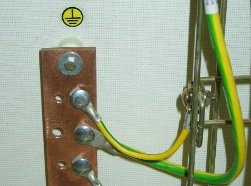 2001 year. A familiar master entrepreneur brought a vertical loading washing machine from Germany, which had worked out factory guarantees in a German family, and offered to buy it for neighbors with a significant discount and bonuses: a free installation and its 3-year warranty.
2001 year. A familiar master entrepreneur brought a vertical loading washing machine from Germany, which had worked out factory guarantees in a German family, and offered to buy it for neighbors with a significant discount and bonuses: a free installation and its 3-year warranty.
We made an agreement and paid the money. The purchase was placed in the kitchen. For seven months the machine worked amazingly, and then, at the most unexpected moment, it flowed while washing the laundry.
It is good that the hostess was at home and from the remote room I heard the sound of pouring water that filled the floor in the kitchen. In addition, the car "shocked" the hostess when she approached her. Naturally, they flooded the neighbors from below.
The called master fixed the malfunction and paid for the repair of two apartments without further questions, and the car still works after this incident.
The reason for the leak is simple: during the preventive replacement of the pressure hose, the master forgot to install the mounting clamp on him. The hose from vibrations arising during operation, flew off the attachment point, and water under the powerful pressure of the water supply network began to fill the inside of the machine, penetrated into the wiring.
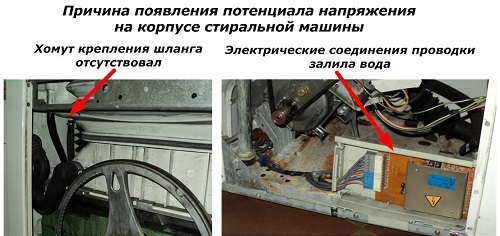
When the insulation between the phase conductor and the housing is wet, then through it the voltage potential appeared on the metal parts of the machine. Therefore, the mistress, standing on the wet floor and holding her hands on the metal case, was shocked. But the protective devices of the input shield did not work.
Electricity input to the apartment was made through 16 amp circuit breakers, the ground circuit worked by TN-C system. The leakage current through the human body was not enough to trigger the protection.
The circuit of the formed electrical circuits in this situation is as follows.
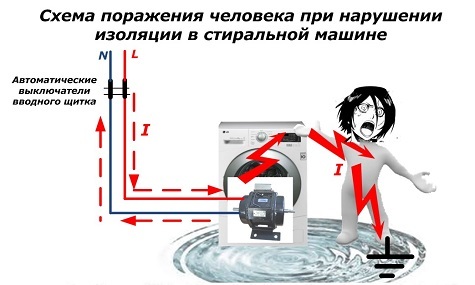
This typical case has long been provided for by the rules for the operation of electrical installations, which at different times suggested using:
-
zeroing;
-
grounding.
Grounding principle
In three-phase AC power systems, the neutral conductor serves many purposes. In matters of electrical safety, it is used to create a short circuit with a phase potential that has penetrated the body of electrical consumers. Arising from this short circuit currentwhen it exceeds the rated value of the protective circuit breaker, it trips last.
Zeroing of the electric device itself is performed by a separate wire connected to the working zero N in the input shield. To do this, use the third core of the supply cable and an additional contact in the electrical outlet.
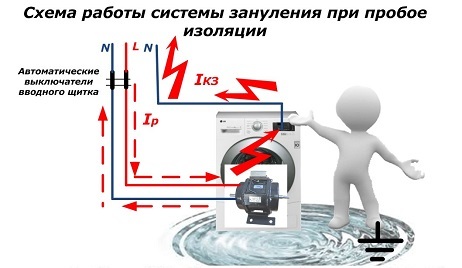
The disadvantage of this method is the need for a leakage current to be greater than the set setting for the protection to operate. When the switch provides the rated operation of electrical appliances under a load of up to 16 amperes, it will not save from small leakage currents.
In the same time human body resistance cannot withstand currents of large quantities. Under aggravating circumstances, 50 milliamps of alternating current is enough to cause cardiac fibrillation and stop it. Zeroing does not protect against such currents. It works when creating critical loads on a circuit breaker.
Grounding principle
Safe operation of household appliances by connecting their housing to protective zero is ensured by operation "Residual current devices" (RCD) or differential circuit breakers. They have a working body that compares the currents entering through the phase wire into the apartment and leaving the zero working conductor.
Under normal power conditions, these currents are equal in magnitude and oppositely directed. Therefore, in the comparison organ, they balance the mutual action, are balanced and ensure the operation of the devices at nominal parameters.
If a breakdown of insulation occurs anywhere in the controlled circuit, then immediately through the damaged section a current begins to flow, which will go to the ground, bypassing the working zero conductor. An imbalance of currents occurs in the comparison organ, which leads to the disconnection of the contacts of the protective device and the removal of the supply voltage from the entire circuit. The setpoint for the operation of the RCD is selected based on the necessary operating conditions for the equipment, and usually can vary from 300 to 10 milliamps. The shutdown time of the malfunction is a split second.
To connect a protective grounding device to the body of the electrical device, a separate PE conductor is used, which is removed from the distribution panel via an individual trunk to a socket equipped with a third, special terminal.
Moreover, its design provides electrical contact of the earth with the housing at the initial moment when the plug is still inserted, and the phase and working zero are not connected in the circuit. At the same time, this contact is removed last when the plug is removed from the outlet. This method creates a reliable grounding of the housing.
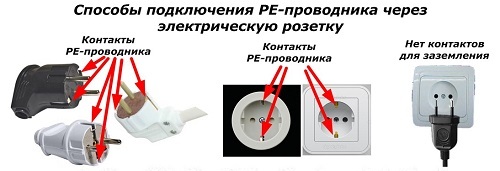
The electrical circuit for grounding using a PE conductor has the following form.
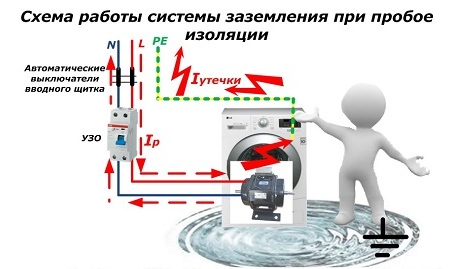
In this circuit, the RCD is mounted inside the apartment panel after the opening machine. It should be borne in mind that it does not at all protect electrical equipment from arising short-circuit currents, even it itself can be damaged by them, requires coordination of its operating parameters with an input circuit breaker.
For this reason, often before an RCD, it is additionally necessary to deliver a circuit breaker of the corresponding rating. RCD functions with a circuit breaker in their design are integrated by a differential machine. Its cost is slightly higher, but it takes up less space during installation.
Features of the use of grounding and grounding in three-phase electrical circuits
The principles of protection of personnel working with industrial and household equipment of a three-phase design comply with all that is stated above. Only for connection to the circuit use three-phase RCDs and difratomata. They constantly compare the sum of currents in all phases and when it changes, they trip to shutdown.
In TN-C three-phase power schemes, there is a case of connecting a motor according to a triangle circuit. In this case, the neutral conductor is released. If it is connected to the case, then additional protection will be obtained on the principle of grounding, which will save equipment and personnel from the occurrence of dangerous potential on the case, eliminate phase short circuits on it.
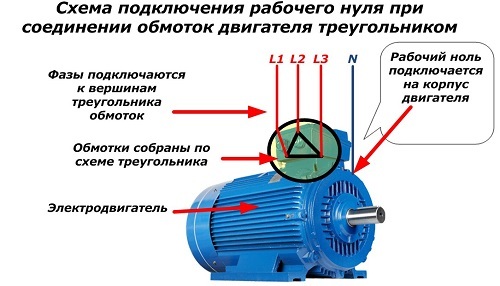
When making electrical connections for grounding, you should carefully analyze the condition of the switched wires and their internal resistance, to ensure reliable contacts. In some cases, the voltage drop across them may be such that the fault current is not enough to trip the circuit breakers or fuses. In this case, the body of the appliance will remain at dangerous potential.
When using grounding or grounding, the response times of the automation must be taken into account. Since safety depends on it, it is necessary to select and establish protection taking into account the minimum possible time for disabling emergency modes.
Thus, the protection functions of grounding and grounding differ in the principles of operation and application, setting up automatic devices.
Using them, it is necessary to take into account that the methods of using grounding and grounding in TT and TN systems have differences that are stipulated by the PUE. They must be observed.
See also at e.imadeself.com
:
